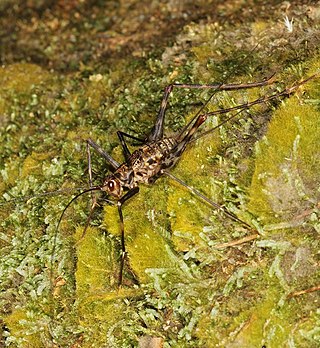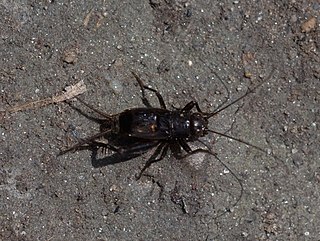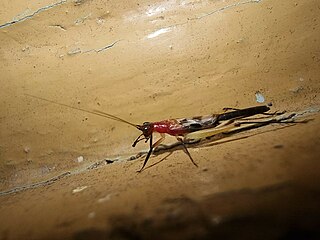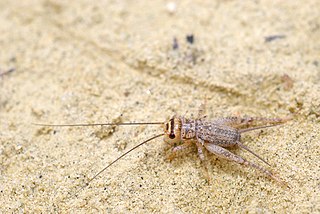
The orthopteran family Rhaphidophoridae of the suborder Ensifera has a worldwide distribution. Common names for these insects include cave crickets, camel crickets, spider crickets, and sand treaders. Those occurring in New Zealand are typically referred to as jumping or cave wētā. Most are found in forest environments or within caves, animal burrows, cellars, under stones, or in wood or similar environments. All species are flightless and nocturnal, usually with long antennae and legs. More than 500 species of Rhaphidophoridae are described.
Talitropsis is a genus of cave wētā in the family Rhaphidophoridae, endemic to New Zealand, and containing six described species. Two Talitropsis species are found only on the Chatham Islands.

Novoplectron is a monotypic genus of cave wētā in the family Rhaphidophoridae, endemic to the Chatham Islands. Cave wētā are nocturnal, wingless crickets that occupy humid habitats. Novoplectron wētā generally live under stones and in burrows of seabirds, such as broad-billed prions, mutton birds and storm petrels.

Pleioplectron is a genus of cave wētā in the family Rhaphidophoridae, endemic to New Zealand. These wētā are fairly common at night among the leaf litter in native forest in the South Island of New Zealand. The species look very similar to species of Miotopus, another New Zealand endemic genus, recently resurrected.

Trigonidiinae is a subfamily of insects in the order Orthoptera, suborder Ensifera, based on the type genus Trigonidium. They are often referred to as sword-tail crickets, winged bush crickets or trigs.

Phalangopsinae, occasionally known as spider crickets, are a subfamily of crickets in the family Phalangopsidae. Members of Phalangopsinae are found worldwide in tropical and subtropical regions. Most species in the subfamily are nocturnal and can be found in rocky areas, near fallen wood, and the understory of forests. Some species are gregarious, gathering in large numbers.

The Eneopterinae are a subfamily of crickets, in the family Gryllidae, based on the type genus Eneoptera. It is one of several groups widely described as "true crickets". Of the more than 500 species that make up this subfamily, most occur in moist, tropical habitats. These insects are medium to large and brown or gray in color. They eat plant leaves, flowers, and fruits and can occasionally cause economic damage. Their eggs are deposited in pith, bark, or wood. Eneopterinae show a great diversity in stridulatory apparatus, signals emitted, and associated behaviour.

Antaxius is a genus of bush crickets in the tribe Platycleidini found in Europe.

Loxoblemmus is a genus of crickets in tribe Gryllini. Species can be found in Africa, Asia and Australia.

Podoscirtinae is a subfamily of crickets in the family Gryllidae.

Pteronemobius is a genus of crickets in the subfamily Nemobiinae, with a worldwide distribution.

Ripipterygidae is a family of insects in the order Orthoptera. Members of the family are commonly known as mud crickets.

Dolichopoda is a genus of cave crickets in the tribe Dolichopodaini, subfamily Dolichopodainae. They are distributed in the Mediterranean basin in southern Europe and western Asia.
Zvenella is a genus of crickets in the tribe Podoscirtini. Species have been recorded in: southern China, Indochina and Sumatra.

Homoeoxipha is a genus of "sword-tail crickets", in the subfamily Trigonidiinae and the tribe Trigonidiini.

Modicogryllus is the type genus of crickets in the tribe Modicogryllini. Species have been recorded from: Europe, Africa, the middle East, temperate and tropical Asia through to Australia and western Pacific islands.
Parendacustes is a genus of crickets in the family Phalangopsidae, tribe Phalangopsini, subtribe Parendacustina. Species have been recorded from Indo-China, Malesia and New Guinea.
Sciobia is a genus of crickets in the family Gryllidae and monotypic tribe Sciobiini; it was erected by Hermann Burmeister in 1838. Species can be found in NW Africa and the Iberian peninsula.

Melanogryllus is a genus of crickets in the family Gryllidae and tribe Gryllini, erected by Lucien Chopard in 1961. Species appear to be widely distributed including: North Africa, mainland Europe and Asia.
Cavernotettix is a genus of cave crickets in the family Rhaphidophoridae, in South-Eastern Australia and Tasmania. There are five species in the genus Cavernotettix. The genus was first described by New Zealand entomologist Aola Richards in 1966.














